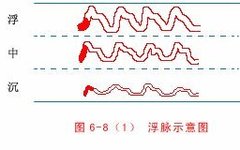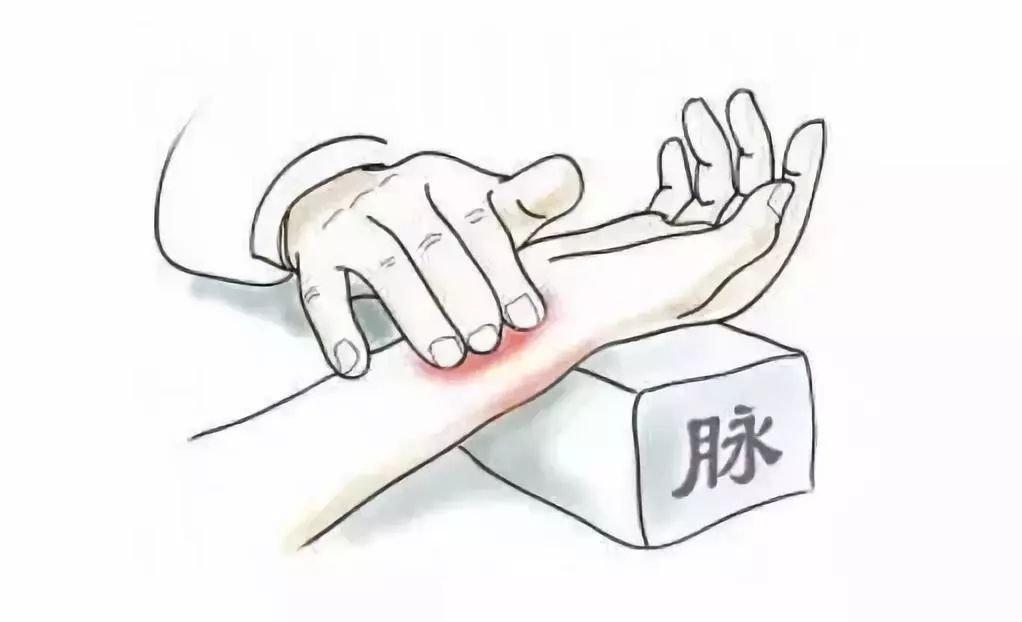
Traditional Chinese Medicine (TCM) pulse diagnosis refers to a diagnostic method where the physician uses their fingers to palpate the patient’s arterial pulse to explore the pulse quality and understand the patient’s condition.
The pulse-taking locations can be divided into three methods: comprehensive examination, three-position examination, and cun-kou examination. The most commonly used are the cun-kou method. The cun-kou is located at the radial artery pulse point behind both wrists, divided into three sections: cun, guan, and chi.The guan is at the high bone of the palm, the cun is before the guan, and the chi is behind the guan. The cun-kou pulse can reflect the qi of the organs: the left cun reflects the heart and small intestine; the left guan reflects the liver and gallbladder; the left chi reflects the kidney and bladder; the right cun reflects the lung; the right guan reflects the spleen and stomach; the right chi reflects the kidney.
When taking the pulse, attention should be paid to the time, posture, and technique. The examination should be conducted in the morning when the patient is inactive. If the patient has been active, they should rest for about 15 minutes before the pulse diagnosis. The patient can be seated or lying down, with the arms extended and palms facing up, bringing the arms close to the same level as the heart. During the pulse-taking, three fingers should simultaneously palpate the pulse with balanced pressure, ranging from light to heavy, categorized into three types of pressure: superficial, moderate, and deep. The pulse diagnosis should last no less than one minute.
The pulse of a healthy person should beat four times with each breath, with pulses present in the cun, guan, and chi sections, not floating or sinking, and should be gentle yet strong. The chi pulse should be strong when taken deeply.Common pulse types include: floating pulse, sinking pulse, slow pulse, rapid pulse, weak pulse, strong pulse, slippery pulse, surging pulse, fine pulse, and wiry pulse.
1. Floating Pulse
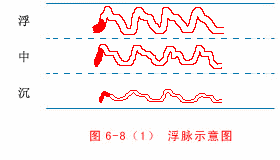
【Body Image Song】Floating on the skin, like wood floating on water; it is excessive when lifted, insufficient when pressed.
【Main Disease Song】Floating pulse is yang, indicating a disease on the surface. Floating at the cun indicates wind; headache and nasal congestion; floating at the left guan indicates wind in the middle jiao; floating at the right guan indicates wind-phlegm in the diaphragm; floating at the chi indicates wind in the lower jiao, with difficulty in urination and constipation.
【Combined Pulse Song】Weak indicates surface deficiency, strong indicates surface excess. Floating tight indicates wind-cold, floating slow indicates wind-stroke; floating rapid indicates wind-heat, floating slow indicates wind-damp. Floating empty indicates blood loss, floating short indicates breathlessness; floating surging indicates empty heat, floating weak indicates heat exhaustion; floating rough indicates blood injury, floating moist indicates qi failure.
2. Sinking Pulse
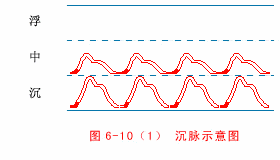
【Body Image Song】Sinking travels through the muscles and bones, like a stone thrown into water; it is excessive when pressed, insufficient when lifted.
【Main Disease Song】Sinking pulse is yin, indicating a disease within. Sinking at the cun indicates shortness of breath and chest pain; it may be phlegm or water with blood. Guan indicates cold in the middle, causing pain and knots; it may be fullness and discomfort, with acid reflux and tight muscles. Chi indicates back pain, also indicating waist and knee issues; dampness and itching below.
【Combined Pulse Song】Weak indicates internal deficiency, strong indicates internal excess. Sinking slow indicates cold accumulation, sinking rapid indicates internal heat; sinking slippery indicates phlegm and fluid, sinking rough indicates blood stasis; sinking weak indicates deficiency and decline, sinking firm indicates accumulation; sinking tight indicates cold pain, sinking slow indicates cold dampness.
3. Slow Pulse
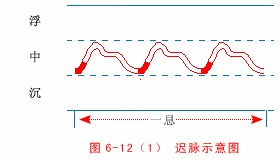
【Body Image Song】Slow pulse belongs to yin, characterized by insufficient frequency; it comes and goes slowly, three beats per breath.
【Main Disease Song】Slow pulse indicates organ issues, with cold as the disease. Slow at the cun indicates cold above, with heart pain and stagnation; slow at the guan indicates cold in the middle, with knots and spasms; slow at the chi indicates fire decline, with incontinence and abdominal pain, or hernia pain.
【Combined Pulse Song】Strong indicates cold accumulation, weak indicates deficiency cold. Floating slow indicates surface cold, sinking slow indicates internal cold; slow rough indicates blood deficiency, slow weak indicates damp cold; slow slippery indicates fullness and bloating, slow faint indicates difficulty in settling.
4. Rapid Pulse
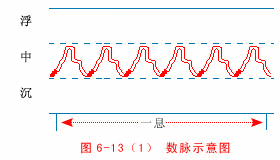
【Body Image Song】Rapid pulse belongs to yang, characterized by excessive frequency; six beats per breath, coming and going rapidly.
【Main Disease Song】Rapid pulse indicates issues with the bowels, with heat as the disease. Rapid at the cun indicates wheezing and coughing, with mouth sores; rapid at the guan indicates stomach heat, with evil fire attacking; rapid at the chi indicates heart fire, with incontinence and difficulty in urination.
【Combined Pulse Song】Strong indicates real fire, weak indicates false fire. Floating rapid indicates surface heat, sinking rapid indicates internal heat. Yang rapid indicates fire excess, yin rapid indicates fire deficiency. Right rapid indicates excessive fire, left rapid indicates yin damage.
5. Slippery Pulse
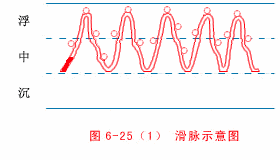
【Body Image Song】Slippery pulse flows smoothly, like a stream; it has the shape of a pearl, symbolizing dew.
【Main Disease Song】Slippery pulse is yang, often indicating phlegm and fluid. Slippery at the cun indicates coughing, fullness in the chest, and nausea; slippery at the guan indicates stomach heat, with obstructed qi and food injury; slippery at the chi indicates urinary issues, or may indicate dysentery, with blood in urine for men and menstrual issues for women.
【Combined Pulse Song】Floating slippery indicates wind-phlegm, sinking slippery indicates phlegm-food. Slippery rapid indicates phlegm-fire, slippery short indicates breath obstruction. Slippery and floating indicates pain in the lower abdomen. Slippery and dispersing indicates stroke paralysis. Slippery and harmonious indicates pregnancy can be confirmed.
6. Rough Pulse
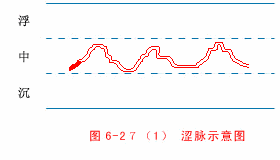
【Body Image Song】Rough pulse is stagnant, like a knife scraping bamboo; it is slow and fine, with three characteristics to fear.
【Main Disease Song】Rough indicates blood deficiency, also indicating essence injury. Rough at the cun indicates heart pain, or palpitations. Rough at the guan indicates yin deficiency, causing internal heat; right guan indicates earth deficiency, left guan indicates flank distension. Rough at the chi indicates urinary issues, with blood in urine; pregnancy indicates fetal issues, with blood loss.
【Combined Pulse Song】Rough and firm indicates real heat; rough and weak indicates false fire.
7. Weak Pulse
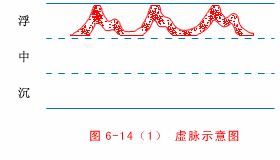
【Body Image Song】Weak pulse is small and soft, appearing in the sinking section; it is not felt when lifted, but can be felt when pressed.
【Main Disease Song】Weak indicates yang deficiency, with true qi decline. Weak at the cun indicates heart deficiency, with palpitations and forgetfulness; weak at the right cun indicates lung deficiency, with spontaneous sweating and breathlessness. Weak at the left guan indicates liver injury, with blood not nourishing the muscles; weak at the right guan indicates spleen cold, with food not digesting. Weak at the left chi indicates water decline, with waist and knee weakness; weak at the right chi indicates fire decline, with cold symptoms.
8. Strong Pulse

【Body Image Song】Strong pulse is powerful, long and firm; it responds strongly to pressure, with all three sections being the same.
【Main Disease Song】Blood strong pulse indicates heat and obstruction. Strong at the left cun indicates heart labor, with tongue strength and qi surging; strong at the right cun indicates lung disease, with nausea and throat pain. Strong at the left guan indicates liver fire and flank pain; strong at the right guan indicates fullness and pain. Strong at the left chi indicates constipation and abdominal pain; strong at the right chi indicates excessive fire and reversal.
【Combined Pulse Song】Strong and tight indicates cold accumulation. Strong and slippery indicates phlegm accumulation.
9. Long Pulse
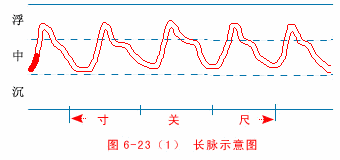
【Body Image Song】Long pulse is long and continuous, with both ends being distinct; it goes straight up and down, like following a long pole.
【Main Disease Song】Long indicates excess, with qi reversal and excessive fire. Long at the left cun indicates fire disease; long at the right cun indicates fullness and reversal. Long at the left guan indicates wood excess; long at the right guan indicates earth fullness and bloating. Long at the left chi indicates running piglet syndrome; long at the right chi indicates excessive fire.
10. Short Pulse

【Body Image Song】Short pulse is rough and small, with both ends drooping; it rises in the middle, unable to fill the entire section.
【Main Disease Song】Short indicates insufficiency, representing qi deficiency. Short at the cun indicates mental instability; short at the right cun indicates lung deficiency and headache. Short at the left guan indicates liver qi injury; short at the right guan indicates disaster in the diaphragm. Short at the left chi indicates lower abdominal pain; short at the right chi indicates true fire not rising.
11. Surging Pulse
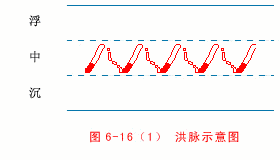
【Body Image Song】Surging pulse is extremely large, resembling a flood; it comes strongly and goes lightly, overflowing the fingers.
【Main Disease Song】Surging indicates fullness, with qi obstruction and excessive fire. Surging at the left cun indicates heart disturbance and tongue damage; surging at the right cun indicates chest fullness and qi reversal. Surging at the left guan indicates excessive wood; surging at the right guan indicates excessive earth heat. Surging at the left chi indicates water depletion and difficulty; surging at the right chi indicates fire burning.
12. Faint Pulse
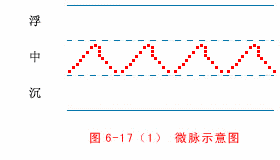
【Body Image Song】Faint pulse is extremely fine and soft; it is almost imperceptible, appearing and disappearing.
【Main Disease Song】Faint pulse is vague, indicating severe qi and blood deficiency. Faint at the left cun indicates fright; faint at the right cun indicates breathlessness. Faint at the left guan indicates cold and spasms; faint at the right guan indicates stomach cold. Faint at the left chi indicates depletion of essence; faint at the right chi indicates decline of yang and life.
13. Fine Pulse
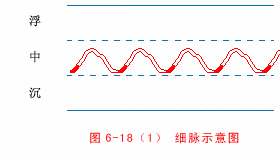
【Body Image Song】Fine pulse is straight and soft, winding and coiling; it resembles a thread, more evident than faint.
【Main Disease Song】Fine indicates qi decline and various deficiencies. Fine at the left cun indicates palpitations and insomnia; fine at the right cun indicates nausea and breathlessness. Fine at the left guan indicates liver yin depletion; fine at the right guan indicates stomach fullness. Fine at the left chi indicates diarrhea and seminal emission; fine at the right chi indicates cold and fatigue.
14. Moist Pulse
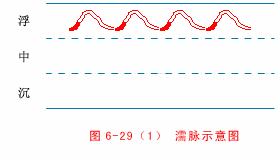
【Body Image Song】Moist pulse is fine and soft, appearing in the floating section; it is seen when lifted, but disappears when pressed.
【Main Disease Song】Moist indicates yin deficiency, with essence depletion. Moist at the left cun indicates forgetfulness and fright; moist at the right cun indicates spontaneous sweating. Moist at the left guan indicates blood not nourishing the muscles; moist at the right guan indicates spleen deficiency and dampness. Moist at the left chi indicates depletion of essence; moist at the right chi indicates fire decline and life loss.
15. Weak Pulse
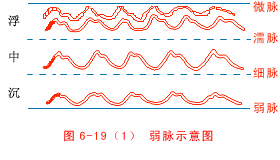
【Body Image Song】Weak pulse is small and soft, appearing in the sinking section; it is not felt when lifted, but can be felt when pressed.
【Main Disease Song】Weak indicates yang deficiency, with true qi decline. Weak at the cun indicates heart deficiency, with palpitations and forgetfulness; weak at the right cun indicates lung deficiency, with spontaneous sweating and breathlessness. Weak at the left guan indicates liver injury, with blood not nourishing the muscles; weak at the right guan indicates spleen cold, with food not digesting. Weak at the left chi indicates water decline, with waist and knee weakness; weak at the right chi indicates fire decline, with cold symptoms.
16. Tight Pulse
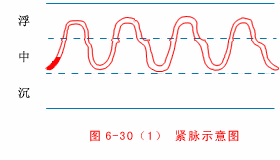
【Body Image Song】Tight pulse is strong, with a snapping sound; it is like twisting a rope or tightening a string.
【Main Disease Song】Tight indicates cold evil, also indicating various pains. Tight at the left cun indicates fullness and acute pain; tight at the right cun indicates cold damage and wheezing. Tight at the left guan indicates floating tightness due to cold; tight at the right guan indicates sinking tightness due to food injury. Tight at the left chi indicates severe pain below the navel; tight at the right chi indicates running piglet syndrome.
17. Slow Pulse
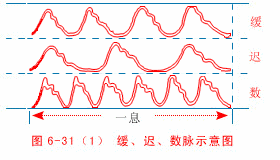
【Body Image Song】Slow pulse has four beats, coming and going evenly; like a gentle breeze, it resembles the willows in early spring.
【Main Disease Combined Pulse Song】Slow indicates stomach qi, not indicating disease; it can only be diagnosed when combined with other pulses. Floating slow indicates wind damage, sinking slow indicates cold dampness. Slow large indicates wind deficiency, slow fine indicates damp obstruction. Slow rough indicates spleen deficiency, slow weak indicates qi deficiency. Right cun floating slow indicates wind evil; left cun rough slow indicates shaoyin blood deficiency.
18. Wiry Pulse
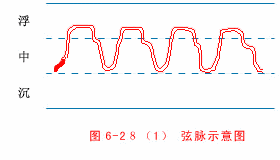
【Body Image Song】Wiry pulse is like a string, light and slippery; it is straight and long, with a firm feel under the fingers.
【Main Disease Song】Wiry indicates liver wind, indicating pain, malaria, phlegm, and fluid. Wiry at the left cun indicates heart pain; wiry at the right cun indicates chest and head pain. Wiry at the left guan indicates phlegm and malaria; wiry at the right guan indicates stomach cold and diaphragm pain. Wiry at the left chi indicates fluid in the lower jiao; wiry at the right chi indicates foot cramps and hernia pain.
【Combined Pulse Song】Floating wiry indicates fluid retention, sinking wiry indicates suspended fluid. Wiry rapid indicates heat, wiry slow indicates cold. Wiry large indicates deficiency, wiry fine indicates tightness. Yang wiry indicates head pain, yin wiry indicates abdominal pain. Single wiry indicates fluid retention, double wiry indicates cold accumulation.
19. Moving Pulse
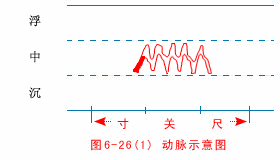
【Body Image Song】Moving pulse has no head or tail, its movement is like beans; it shakes and sways, often combined with slippery and rapid.
【Main Disease Song】Moving pulse indicates pain, also indicating fright. Moving at the left cun indicates fright and palpitations; moving at the right cun indicates spontaneous sweating without doubt. Moving at the left guan indicates fright and spasms; moving at the right guan indicates heart and spleen pain. Moving at the left chi indicates loss of essence; moving at the right chi indicates rapid fire.
20. Rapid Pulse

【Body Image Song】Rapid pulse is quick and urgent, with a stop every few beats; it is like rushing and stumbling, advancing leads to death.
【Main Disease Song】Rapid indicates excessive fire, also due to stagnation. Rapid at the left cun indicates heart fire; rapid at the right cun indicates lung wheezing. Rapid at the left guan indicates blood stagnation; rapid at the right guan indicates food stagnation. Rapid at the left chi indicates concern for loss; rapid at the right chi indicates burning heat.
21. Knotted Pulse
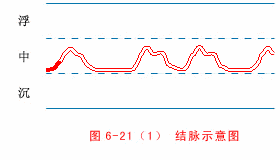
【Body Image Song】Knotted pulse indicates stagnation, with pauses in between; it moves slowly and lazily, often indicating a specific meaning.
【Main Disease Song】Knotted indicates yin cold, also indicating accumulation. Knotted at the left cun indicates heart cold, with pain that can be resolved; knotted at the right cun indicates lung deficiency, with qi cold accumulation; knotted at the left guan indicates hernia; knotted at the right guan indicates phlegm stagnation and food retention. Knotted at the left chi indicates weakness; knotted at the right chi indicates yin cold symptoms.
22. Intermittent Pulse

【Body Image Song】Intermittent pulse indicates a change, with a constant number; it cannot return to normal, and takes a long time to move again.
【Main Disease Song】Intermittent indicates organ decline, a sign of danger. Spleen earth failure indicates vomiting and diarrhea; middle cold leads to difficulty in eating, with abdominal pain that is hard to relieve. Two movements and one stop indicate death in three to four days; four movements and one stop indicate death in six to seven days. Sequentially deducing does not lose the essence of the classics.
23. Leather Pulse

【Body Image Song】Leather pulse is large and tight, easily felt when floating; it feels empty when pressed, like a drum skin.
【Main Disease Song】Leather indicates surface cold, also indicating internal deficiency. Leather at the left cun indicates heart blood deficiency; leather at the right cun indicates metal decline and qi obstruction. Leather at the left guan indicates hernia; leather at the right guan indicates earth deficiency and pain. Leather at the left chi indicates essence depletion; leather at the right chi indicates death concerns. Women with this pulse may experience postpartum bleeding.
24. Firm Pulse

【Body Image Song】Firm pulse is found in the sinking section, large and wiry; it is difficult to feel in the floating section.
【Main Disease Song】Firm indicates solid accumulation, with disease within. Firm at the left cun indicates hidden illness; firm at the right cun indicates breath regulation. Firm at the left guan indicates liver blood accumulation; firm at the right guan indicates cold and fullness. Firm at the left chi indicates running piglet syndrome; firm at the right chi indicates severe hernia pain.
25. Dispersed Pulse
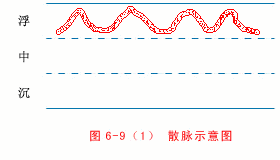
【Body Image Song】Dispersed pulse is floating and chaotic, with surface but no interior; the middle section gradually empties, pressing leads to disappearance.
【Main Disease Song】Dispersed indicates primary injury, indicating danger. Dispersed at the left cun indicates palpitations and insomnia; dispersed at the right cun indicates spontaneous sweating. Dispersed at the left guan indicates fluid retention; dispersed at the right guan indicates fullness and illness. Located at the left chi indicates water depletion; located at the right chi indicates yang loss and death.
26. Hollow Pulse
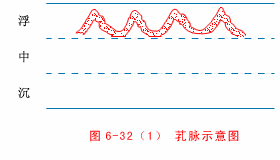
【Body Image Song】Hollow pulse is empty, resembling a green onion; it has both floating and sinking qualities, with the middle section being empty.
【Main Disease Song】Hollow pulse indicates internal emptiness, hence indicating blood loss. Hollow at the left cun indicates heart blood loss; hollow at the right cun indicates yin injury. Hollow at the left guan indicates liver blood not stored; hollow at the right guan indicates spleen blood not absorbed. Hollow at the left chi indicates red urine; hollow at the right chi indicates fire burning and essence leaking.
27. Hidden Pulse
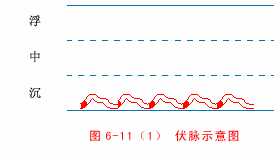
【Body Image Song】Hidden pulse is concealed, deeper than sinking; it feels like pushing on muscles and bones to find its shape.
【Main Disease Song】Hidden pulse is yin, indicating deep-seated illness. Hidden at the left cun indicates blood stagnation; hidden at the right cun indicates qi stagnation. Hidden at the left guan indicates liver blood in the abdomen; hidden at the right guan indicates cold accumulation in food. Hidden at the left chi indicates hernia; hidden at the right chi indicates yang loss.
28. Rapid Pulse
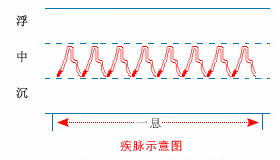
【Body Image Song】Rapid indicates extreme urgency, with the highest frequency; seven to eight beats, the pulse flows thinly and rapidly.
【Main Disease Song】Rapid indicates extreme yang, with yin qi about to deplete; the pulse is irregular, indicating a potential loss of spirit; gradually increasing in speed, often leading to death. Rapid at the left cun indicates self-immolation; rapid at the right cun indicates metal being consumed by fire. Rapid at the left guan indicates liver yin depletion; rapid at the right guan indicates spleen yin depletion. Rapid at the left chi indicates difficulty in moistening; rapid at the right chi indicates excessive heat.
SpreadTCM health knowledge, promote traditional Chinese culture,share health concepts, and convey care, passing health knowledge and traditional culture to more friends…
People are great because they have dreams; we are different because we have love.
Liu Qing Ning: 186 9643 6785 or (WeChat ID)
Yang Shun Song: 138 7171 7447 or (WeChat ID)


